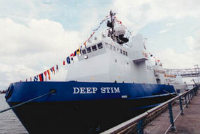What's happening in production
HARC heralds new production technology; new completion vesselsDr. Brian Samaroo of Production Testing Services in Houston recently received a U.S. patent for a new production-testing technology. Called the Production Profile Predictor Method, or 3PM, it monitors production from commingled reservoirs using standard surface-production test data. It can reduce the cost and risk incurred with conventional downhole production-testing methods. The 3PM technology is applicable to wells producing gas / oil, gas / water or gas/oil / water. Production can come from one or more zones; production must be commingled when there is more than one zone. The technology can be used for multiple completions and artificial lift, as long as the above conditions are met. For each productive zone, two stabilized production tests yield the following information, the first four of which, by analogy, also apply to each thief zone:
The Houston Advanced Research Center (HARC) is offering open participation in a new research coalition to further test and enhance 3PM. Each coalition participant will receive a complete 3PM production analysis for up to five wells of their choice, as well as an accuracy report for all wells analyzed. The participant fee is $25,000 and includes two technology transfer seminars to be conducted by Dr. Samaroo and Production Testing Services. For more information contact: Tricia Ransom at 281-364-6088 or transom@harc.edu. Caspian pipeline deal. The leaders of Turkey, Azerbaijan, Georgia, Kazakhstan and Turkmenistan signed agreements for finance and construction of oil and gas pipelines from the Caspian Sea to the Turkish coast. Four agreements were signed that were essential to establishing a safe and reliable pipeline across Turkey that bypasses Istanbul’s Bosphorous Strait. Basic engineering and project-financing activities for the Baku-Ceyhan crude pipeline will begin in early 2000. Estimated cost of the 1,080-mi, million-bopd pipeline is $2.4 billion. A team of U.S.-based project advisors, funded by the U.S. Trade and Development Agency, together with Pace Global Energy Services, played a key role by providing legal, financial and commercial advisory support. New stimulation vessels. Two new, advanced stimulation vessels were launched last month. Schlumberger’s DeepSTIM is designed for severe weather and deepwater service, with a fully enclosed North Sea-style deck that eliminates exposure of equipment and personnel to weather. The vessel uses a dynamic positioning system with both GPS and sonar to maintain position. It can deliver 12,700 hhp with rates as high as 50 bbl/min. Power can be increased to 19,500 hhp with 48-hr notice.
A process-controlled, continuous-mix fluid system allows on-the-fly mixing of both acid and frac fluids using fresh water or seawater – greatly minimizing fluid waste and reducing material costs. The vessel also features a high-speed satellite communications package, allowing wellsite information to be transferred in real time to multiple client locations. DeepSTIM joins Schlumberger’s BigOrange 29, BigOrange 30 and Galaxie, already in service. Baker Hughes’ new completion and stimulation vessel, the RC Baker, measures 224 ´ 54 ft and is GPS/dynamically positioned. It sports a 50 bbl/min., continuous-mix, frac-fluid rate and 15-bbl/min., continuous-mix acid rate. It can store a million lb of proppant and can deliver proppant at rates between 100 and 15,000 bbl/min. The RC Baker carries 300 ft of 3-in., 15,000-psi working pressure Coflexip hose and a back-down winch for deepwater facilities. The vessel also features satellite and cellular phone data-transmission capabilities. Elf begins production. Platform L4PN, part of a joint development project of several new gas fields on the Dutch continental shelf, saw first production in late November. The project was conceived to allow savings due to the proximity of the fields. As more wells are added from the other fields, gas production should average about 88 MMcfd. Partners include TOTAL and Energie Beheer Nederland B.V. Elf also began producing from Virgo field in the Gulf of
Mexico. This comes two-and-a-half years after the discovery well. The field covers four
blocks in the Viosca Knoll region off the coast of Louisiana. Daily production will increase
to about 23,000 boe as development wells, which began drilling in October, are brought
online. Elf’s partners are Coastal Oil & Gas, Pogo Producing and Nippon Oil &
Gas.
Copyright © 2000 World
Oil |




